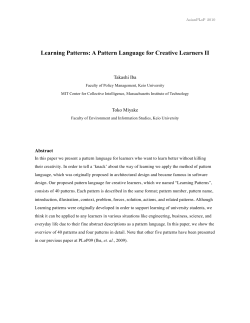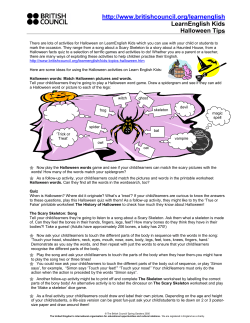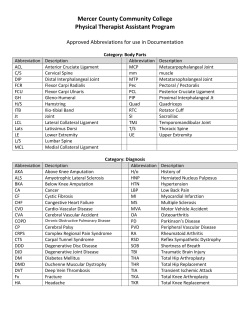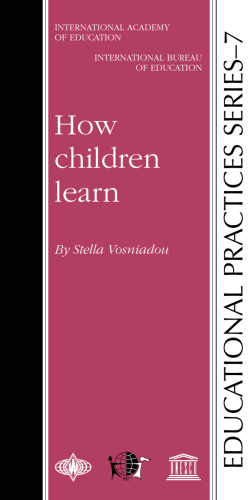
Document 59361
Cambridge TECHNICALS OCR LEVEL 2 CAMBRIDGE TECHNICAL CERTIFICATE/DIPLOMA IN HEALTH AND SOCIAL CARE CREATIVE AND THERAPEUTIC ACTIVITIES IN HEALTH AND SOCIAL CARE D/600/6885 LEVEL 2 UNIT 9 GUIDED LEARNING HOURS: 60 UNIT CREDIT VALUE: 10 CREATIVE AND THERAPEUTIC ACTIVITIES IN HEALTH AND SOCIAL CARE D/600/6885 LEVEL 2 UNIT 9 AIM OF THE UNIT PURPOSE OF THE UNIT Most people enjoy some sort of creative or therapeutic activity such as dancing, music, sport, looking after pets or perhaps cooking. Time spent doing activities we enjoy does not only make us feel good, but can also be beneficial to us within other areas of our lives. This unit will enable learners to gain some appreciation the benefits of creative and therapeutic activities –which is essential knowledge when working within health and social care. Learners will gain some understanding of how to plan and safely deliver appropriate, stimulating, creative and therapeutic activities to support the diverse needs of people who use services. People who use services have a diverse range of needs and learners will gain knowledge and understanding of how some of those needs may be met through the provision of creative and therapeutic activities. Learners will gain an appreciation of the holistic benefits of creative and therapeutic activities to support the cognitive, physical, emotional and social needs. Learners will also gain an understanding of the relevant legislation related to carrying out activities safely within a range of settings. The importance of following the wishes and interests of people who use services when planning activities will be explored. Learners will develop an understanding of the role of the practitioner within activities, to ensure inclusion, appropriate support and enjoyment is experienced by everyone taking part in creative and therapeutic activities. www.ocr.org.uk 2 Creative and Therapeutic Activities in Health and Social Care Level 2 Unit 9 ASSESSMENT AND GRADING CRITERIA Learning Outcome (LO) Pass 1 Know different creative and therapeutic activities and their benefits P1 Identify creative and therapeutic activities for people using health and social care services Merit The assessment criteria are To achieve a merit the the pass requirements for evidence must show that, this unit. in addition to the pass criteria, the learner is able to: The learner will: The learner can: 2 Know legislation and regulations relevant to the implementation of creative and therapeutic activities To achieve a distinction the evidence must show that, in addition to the pass and merit criteria, the learner is able to: M1 describe ways creative and therapeutic activities benefit individuals using health and social care services P2 Identify the benefits of creative and therapeutic activities for individuals using health and social care services P3 Identify health and safety legislation and guidelines relevant to the implementation of creative and therapeutic activities 3 Understand the role of P4 Explain the role of the professionals supporting professional when individuals who undertake planning creative and creative and therapeutic therapeutic activities in activities a health and social care environment 4 Be able to implement appropriate creative and therapeutic activities Distinction D1 analyse ways professionals could encourage inclusion when supporting creative and therapeutic activities in a health and social care environment P5 Plan a creative or therapeutic activity for an M2 carry out a planned individual using health or creative or therapeutic social care services activity in a health or social care service 3 D2 evaluate the appropriateness of resources used in a creative or therapeutic activity in a health or social care service TEACHING CONTENT The unit content describes what has to be taught to ensure that learners are able to access the highest grade. Anything which follows an i.e. details what must be taught as part of that area of content. Anything which follows an e.g. is illustrative, it should be noted that where e.g. is used, learners must know and be able to apply relevant examples to their work though these do not need to be the same ones specified in the unit content. 1 Know different creative and therapeutic activities and their benefits • Creative and therapeutic activities: used in health and social care settings, (e.g. expressive art, craft, photography, gardening, music, dance, movement, drama, cookery, exercise, games, sport, swimming, horse riding, quizzes, ICT, yoga, massage, multi-sensory stimulation, animals as therapy) • Health and social care setting: pre-school; day care; residential care; domiciliary care; community groups; independent living; hospitals • Physical benefits: maintain and/or improve movement, strength, coordination, dexterity, hand-eye coordination; reduce symptoms • • • 3 Understand the role of professionals in supporting individuals who undertake creative and therapeutic activities Cognitive benefit: memory; problem solving; communication; organisation Principles and values: anti-discriminatory practice; equality of opportunity; empowering; ensuring dignity, promoting independence; confidentiality; respecting diversity, culture, beliefs • Supporting inclusion within individual and group activities: (e.g. development of friendships; methods of communication; encouraging new experiences, pairing up, group work, adaptations to resources/environment to ensure inclusion within group activities) • Support activities: motivate; supporting enjoyment; offer practical help; provide resources; being available; health; safety; security. 4 Be able to implement appropriate creative and therapeutic activities Emotional benefits: motivation; self-concept; self esteem; develop new interests • Factors affecting choice of activities: (e.g. potential benefit, interests, preferences, age, ability, physical ability, intellectual ability, communication skills, culture, gender) • Needs of the individual: (e.g. physical, sensory, social isolation, learning disability, depression, developmental, communication) • Plan creative and therapeutic activities: needs of individual; timing; resources (e.g. materials, equipment; space/setting; barriers; health and safety) • Resources: (e.g. art and craft materials, games, music; equipment e.g. digital cameras, recording equipment, computer, cooking ingredients, gardening equipment) • Specialist resources: (e.g. large print games, cards, texts, easy grip scissors or tools, talking books, grips, non-slip mats, computer touch pad or screens). Social benefits: interaction with others; development of relationships and social networks. 2 Know legislation and regulations relevant to the implementation of creative and therapeutic activities • • Legislation, regulations, codes of practice: relevant sections from appropriate legislation (e.g. Health and Safety at Work Act 1974, The Food Standards Act 1999, The General Food Regulations 2004, The Manual Handling Operations Regulations 1992, Control of Substances Hazardous to Health Regulations, 2002 (COSHH), The Reporting of Injuries, Diseases and Dangerous Occurrences Regulations 1995, (RIDDOR), organisational policies and codes of practice, Equality Act 2010, EYFS). www.ocr.org.uk 4 Creative and Therapeutic Activities in Health and Social Care Level 2 Unit 9 DELIVERY GUIDANCE safely. Food related activities will need to comply with The General Food Regulation 2004 legislation. Risk assessment to identify hazards and reduce the risk of harm/injury should be considered (this links well to unit 4) LO1 Know different creative and therapeutic activities and their benefits This unit lends itself to being delivered in a very practical way. Groups of learners could be given scenarios outlining a setting and the needs of the people who use its services and then asked to suggest a range of appropriate activities to meet those needs. For example children in a day nursery enjoying sand play, a dough making activity within an after school club or older adults within a residential care setting taking part in a singing activity. This could be delivered in a ‘round robin’ style activity with learners in small groups adding activity ideas to given scenarios of settings or groups of people who use services, and then exchanging scenarios with other groups adding more ideas, this will then allow learners to build up a bank of appropriate activity ideas. Learners could be given the opportunity to try out different activities within a ‘carousel session’ where small groups of learners set up different activities and learners can move around trying out each activity. A guest speaker from a setting with responsibility for health and safety may be able to give learners information about the consideration of legislation and regulations, based on practical examples for their own practice. LO3 Understand the role of professionals in supporting individuals who undertake creative and therapeutic activities Learners should have a sound understanding of the role of the practitioner to ensure all individuals have the support and encouragement they need to benefit from the activity. There could be a discussion around the criteria outlined in LO3 reinforcing the need to ensure anti-discriminatory practice, preserving dignity, respecting diversity Again a guest speaker with experience of supporting individuals undertaking creative and therapeutic activities may help learners to understand the importance of being able to motivate and encourage participants. Scenarios could be given to learners to encourage them to consider the needs of each individual and suggest ways that individuals can be supported when taking part in creative and therapeutic activities. For example a child reluctant to join in with other children, an older adult who is finding it difficult to cope with living in residential care or a young person in hospital who feels frightened. The physical, cognitive, social and emotional benefits of creative and therapeutic activities need to be clearly understood by learners. Learners should be given a clear overview of each aspect of development (physical, cognitive, social and emotional) through tutor presentation or active handouts. Their knowledge can be consolidated by allowing learners to take part in activities in small groups for example making dough or a collage activity. Then ask learners to write down how they thought that particular activity supported each area of benefit. e.g. During a dough activity; cognitive – following instructions, measuring ingredients. Physical – kneading the dough, mixing, making shapes. Social – sharing roles, communication. Emotional – feelings, enjoying the textures. LO4 Be able to implement appropriate creative and therapeutic activities Learners should be encouraged to plan an activity (in pairs or very small groups) this could be a simple music or craft activity. Learners should prepare appropriate resources, taking into consideration the needs of the participants, for example young children or some other groups may be at risk of injury if using scissors or sharp tools used when cooking. The learners could then ask another pair of learners to try the activity they have planned. This would allow learners to pick up any short falls in their planning and implementation via a short evaluation of the activity, or note any aspects of the activity that were particularly successful or require changing. E.g. instructions given to participants too complicated or not enough resources for the planned number of participants. The pairs of learners could then discuss how the activity could be improved. Learners should be introduced to the concept of constructive criticism, (both sensitively giving and accepting ideas for improvement) understanding that it is a valid means to improve practice. LO2 Know legislation and regulations relevant to the implementation of creative and therapeutic activities Requires learners to have an understanding of legislation that underpins safety within creative and therapeutic activities, for example when planning activities for children within a day care setting the EYFS should be considered and risk assessments carried out. It may be beneficial to look at the Equality Act 2010 to ensure learners are able to make recommendations for inclusivity when planning. (relates to M1). When planning for a range of people who use services the Health and Safety at Work ACT 1974 should be looked at, along with COSHH and RIDDOR. Learners should be introduced to the Manual Handling Operations Regulations 1992, to ensure equipment and people are moved around 5 SUGGESTED ASSESSMENT SCENARIOS AND TASK PLUS GUIDANCE ON ASSESSING THE SUGGESTED TASKS LO1 Example activity plan: P1 This criterion would/could be assessed through a written list of suitable creative and therapeutic activities for a range of different settings/people who use services, learners being encouraged to give a brief description of the activity. Activity (title) Type of setting Size of group Time required List of resources needed How the activity will be introduced to the participants P2 A written account of how specific activities can benefit individuals’ physical, cognitive social and emotional development, would be a suitable approach to this criterion. Giving specific descriptions of activities might help learners to put the benefits into context. What will the participants actually do/what support will they need? Physical benefits Cognitive/intellectual benefits Social benefits Emotional benefits LO2 P3 A written assignment or presentation would best fit this criterion. Learners need to clearly identify the legislation. Adaptations to the activity and ways the professional can ensure inclusion of all. LO3/LO4 (P4 P5 M1 M2 D1 D2 D3) The above criteria could be evidenced via an activity plan pro-forma, which should be developed to guide learners through the planning, implementation and evaluating process. To ensure learners have the opportunity to meet all of the criteria the table must include the following information; Evaluation of resources and suggestions for improvement (complete this section at the end of the activity). This type of activity plan would allow learners to systematically cover the criteria, developing strong practical application during the process. Evaluation should be undertaken after the activity has been implemented. • • • • • • • Title of activity Type of setting Needs of the people who use services / size of group Time needed to complete the activity Resources needed How the activity will be introduced to the participants What will the participants actually do/what support will they need. • What are the cognitive, physical, emotional and social benefits of the activity • Adaptations that can be made to the activity to ensure inclusion of all • Evaluation of resources and suggestions for improvement of the activity (at the end of the activity) www.ocr.org.uk 6 Creative and Therapeutic Activities in Health and Social Care Level 2 Unit 9 MAPPING WITHIN THE QUALIFICATION TO THE OTHER UNITS Unit 2: Individual Needs in Health and Social Care Unit 4: Ensuring Safe Environments in Health and Social Care Unit 5: Vocational Experience in a Health or Social Care Setting LINKS TO NOS HSC21 Communicate with and complete records for individuals c – Communicate with individuals HSC22 Support the health and safety of yourself and individuals a – Carry out health and safety checks before you begin work b – Ensure your actions support health and safety in the place you work HSC23 Develop your knowledge and practice a – Evaluate your work b – Use new and improved skills and knowledge in your work HSC24 Ensure your own actions support the care, protection and well-being of individuals a – Relate and support individuals in the way they choose b – Treat people with respect and dignity 7 CONTACT US Staff at the OCR Customer Contact Centre are available to take your call between 8am and 5.30pm, Monday to Friday. We’re always happy to answer questions and give advice. Telephone 02476 851509 Email [email protected] www.ocr.org.uk
© Copyright 2024





















